The New York Times has a love affair with Portland, but a recent article points to a dark side of Portland that the Antiplanner has commented on before: it is (as Harvard economist Edward Glaeser once put it) a “boutique city catering only to a small, highly educated elite.”
That means there isn’t much room in Portland for chronically low-income blacks. The black “ghetto,” as we called parts of Northeast Portland when I was growing up there, has been gentrified by yuppies who can’t afford homes elsewhere in the region’s urban-growth boundary. This has pushed blacks from rental housing in those neighborhoods, leaving just a scattering of blacks who owned their homes.
What is left “is not drug infested, but then you say, ‘Well, what happened to all the black people that were in this area?’ ” Margaret Solomon, a long-time black resident told the Times. “You don’t see any.” As California writer Joseph Perkins put it, “smart growth is the new Jim Crow.”











